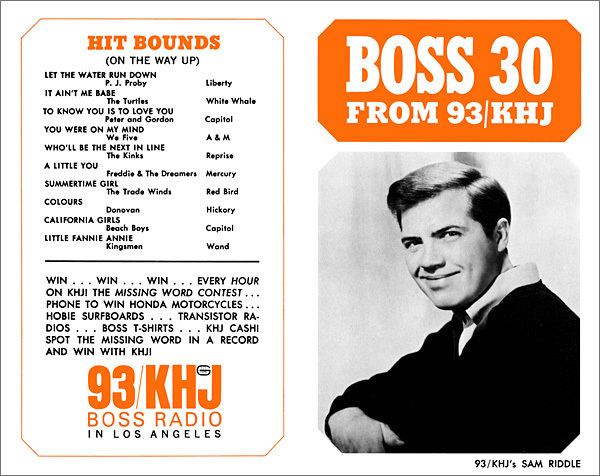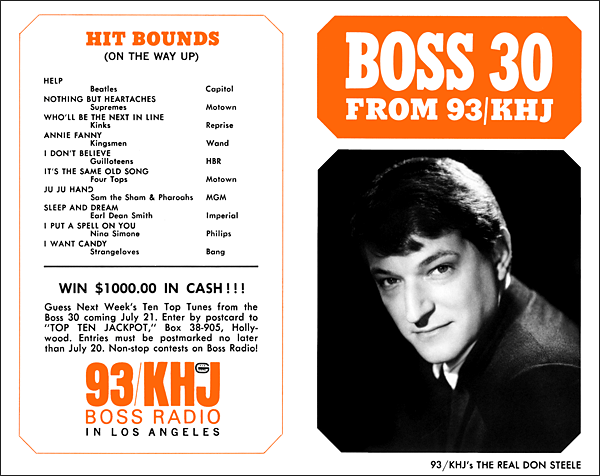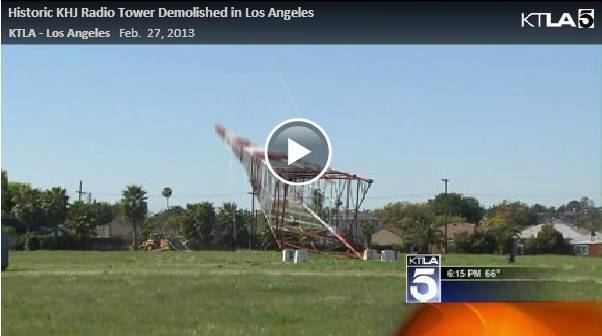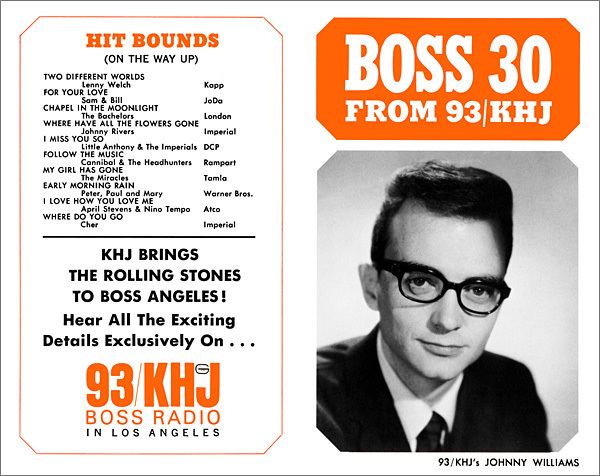Language(s) English Class B City of license Los Angeles Owner Immaculate Heart Radio Sister stations KBUE, KBUA, KEBN | Frequency 930 kHz Format Religious broadcasting Area Los Angeles | |
 | ||
Broadcast area Los Angeles metropolitan area First air date April 13, 1922; 94 years ago (1922-04-13) Call sign meaning Kindness, Happiness and Joy | ||
KHJ (930 kHz) is an AM radio station licensed to Los Angeles, California. Owned and operated by Immaculate Heart Radio, through licensee IHR Educational Broadcasting, the station broadcasts Roman Catholic religious programming as an affiliate of the radio network.
Contents
- 1920s and 1930s
- Boss Radio
- End of an era
- Switch to Spanish and call sign problem
- Dodgers broadcast contract
- Switch to Catholic Radio format
- Other KHJs
- References

KHJ broadcasts at 5,000 watts, with a non-directional signal by day but using a directional antenna at night to protect other stations on AM 930. KHJ's transmitter is triplexed to three of the six towers of KBLA (1580 kHz), near the intersection of Sunset Boulevard and Alvarado Street in the Echo Park neighborhood of Los Angeles. Radio station KYPA (1230 kHz) also uses two of KBLA's towers for its signal. KHJ's former towers at the intersection of Venice and Fairfax Avenue were removed in February 2013.

KHJ was a nationally noted Top 40 station from 1965 to 1980. KHJ switched to country music in 1980 and back to pop music in 1983. In 1986 the station switched its call letters to KRTH, adopting an oldies radio format as a sister station to 101.1 KRTH-FM. Two years later the station was sold to Liberman Broadcasting and a format of Regional Mexican music aired from 1990 to November 2014.

1920s and 1930s

KHJ went on the air at 720 AM on April 13, 1922. It later moved to 760 AM in response to increased interference on the AM band. The Federal Radio Commission (FRC) regulated the band in 1927-28 and reassigned KHJ to the regional-service frequency of 900 kHz with 1000 watts of power, where it remained until 1941. At that point, a reorganization of the AM band by the Federal Communications Commission (successor to the FRC) in conjunction with the North American Regional Broadcasting Agreement raised KHJ's power to 5,000 watts and moved to 930 kHz (where it continues to operate).

Founded by Charles R. Kierulff, owner of C. R. Kierulff & Company, KHJ was sold to the Times Mirror Company (owner of the Los Angeles Times) in late 1922. For a short time during the late 1920s and early 1930s it was the Los Angeles affiliate and West Coast production hub of the fledgling CBS radio network, the originating station for Bing Crosby's first national network radio show in 1931. CBS would eventually purchase a more-powerful West Coast flagship station, 50,000-watt KNX, and part company with KHJ. The station was then purchased by Don Lee, a local automobile dealer who also owned 610 KFRC in San Francisco and eventually accumulated 21 radio stations. In 1949 the broadcasting company, including KHJ, merged with RKO General. Its call letters were said to stand for "Kindness, Happiness and Joy," although in fact, they were sequentially assigned.
During Lee's ownership KHJ became the West Coast flagship station of the Mutual Broadcasting System, one of the "big four" radio networks (with CBS, NBC and ABC) from the 1930s to the 1970s. George Burns, Gracie Allen and Steve Allen appeared on KHJ, and at one point the station employed a 50-piece orchestra to accompany its musical guests. On a 1931 broadcast (a portion of which survives) KHJ introduced an up-and-coming singer, Bing Crosby. Pat Weaver (president of NBC, creator of The Today Show and The Tonight Show and father of Sigourney Weaver) was a KHJ announcer.
"Boss Radio"
In April 1965, programming consultant Bill Drake crafted KHJ's top-40 format. Drake hired program director Ron Jacobs, who had created formats in Hawaii and California. The format featured a restricted playlist and restrained commentary by announcers (although a few, such as Robert W. Morgan, Charlie Tuna, Humble Harve and The Real Don Steele, were allowed to develop on-air personalities). Other DJs from 1965-68 included Roger Christian, Gary Mack, Dave Diamond, Sam Riddle, Johnny Williams, Frank Terry, Johnny Mitchell, Tommy Vance, Scotty Brink, Steve Clark, Bobby Tripp, Tom Maule and Bill Wade. Part of the format, known as "Boss Radio", were jingles by the Johnny Mann Singers. "Boss Radio" spread throughout the U.S., bringing high ratings to KFRC in San Francisco, WFIL in Philadelphia, KGB in San Diego, WQXI in Atlanta, CKLW in Windsor, Ontario and WRKO in Boston. Drake and Gene Chenault brought many of their announcers from the other "Boss" stations, using them as a proving ground for talent.
KHJ's call-in request number used the Los Angeles area code 213 and a 520 exchange, followed by the current year. During the late 1970s and early 1980s, the station competed with three other local stations with similar formats: KFI, KTNQ and San Diego-based XETRA-AM, which operated as "The Mighty 690". KHJ competed with four "soul radio" stations serving the Los Angeles radio market: KDAY and KGFJ in Los Angeles and border blaster XERB in Rosarito, Mexico (south of San Diego).
During the summer of 1970, a KHJ contest led to a fatality and a large legal judgment against RKO General. That summer the station ran a series of contests, known as the Super Summer Spectacular. In the contests, the Real Don Steele drove a red car to a particular area and announcers encouraged listeners to find him with clues as to his whereabouts. The first person who found Steele and fulfilled a condition received a cash prize and was interviewed by Steele. The conditions varied, from answering a question to possessing certain items of clothing. An example of an on-air clue was: "The Real Don Steele is moving into Canoga Park — so be on the lookout for him. I'll tell you what will happen if you get to The Real Don Steele. He's got twenty-five dollars to give away if you can get it ... and baby, all signed and sealed and delivered and wrapped up." At the time, KHJ had the largest teenage audience in the Los Angeles area (48 percent, compared to its nearest competitor's 13 percent).
On July 16, 1970 two teenagers, following Steele in separate cars, drove at speeds up to 80 miles per hour (130 km/h) so they could be closest to him when the next clue was announced. One of the teenagers forced another motorist, 32-year-old Ronald Weirum, off the road; Weirum was killed when his car overturned.
Weirum's wife and children filed a wrongful-death suit against both teenagers, the manufacturer of Weirum's car and RKO General, and one of the teenagers settled with the before trial for the limits of his insurance policy. A jury found in favor of the car's manufacturer, finding the second teenager and RKO General liable for the accident and awarding $300,000 in damages.
RKO General appealed to the California Supreme Court, which upheld the verdict in 1975. The higher court ruled that KHJ negligently created an undue risk to the public by causing a situation in which its listeners were encouraged to race on the roads, and there was sufficient evidence for the jury to find that the contest's risk of harm to the public (including Weirum) was foreseeable.
End of an era
The format brought high ratings to the station until the late 1970s, when FM radio became the dominant form of music broadcasting. In November 1980, during the Bob Shannon show, "93 KHJ" switched from top-40 to country music. The country format, with the slogan "We all grew up to be cowboys", lasted three years before it was changed to an oldies format: "The Boss is Back", with the original Johnny Mann Singers "Boss Radio" jingles, on April 1, 1983. In 1984, the station tried a top-40 variant: "Car Radio", with traffic reports every ten minutes.
On the evening of January 31, 1986, "Car Radio" DJ Dave Sebastian Williams was joined in the studio by Robert W. Morgan. Participants in KHJ's Boss Radio heyday (DJs M.G. Kelly, Bobby Ocean and Jimmy Rabbitt, and program director Ron Jacobs) phoned in for a farewell broadcast, playing the songs which had made KHJ a popular AM station in the 1960s and 1970s. The last song played on KHJ was Rock Around The Clock by Bill Haley & His Comets. At midnight that night, the station changed its call letters to KRTH, matching those of its FM sister station, with a format known as "Smokin' Oldies", featuring hits from the rock and roll era's first decade. The station used "AM 930" as its moniker.
Switch to Spanish and call-sign problem
RKO General had been under investigation by federal regulators since the 1960s for unethical conduct at its television stations, including KRTH's television sister KHJ-TV (later KCAL-TV). The company was eventually ruled an unfit broadcast licensee, and was compelled by the FCC to sell its broadcast properties. During the summer of 1989, KRTH and KRTH-FM were sold to Beasley Broadcasting, which sold KRTH to Liberman Broadcasting. It became a full-time Spanish-language station, adopting the call letters KKHJ in honor of its history.
Program director Alfredo Rodriguez and chief engineer Jerry Lewine wished to bring back the three-letter call sign; however, the FCC stopped issuing three-letter call signs to radio stations during the 1930s. Rodriguez and Lewine conceived a plan to convince the FCC to change the station's call sign. Since the Spanish version of KKHJ's first two letters ("kah-kah") sounded like caca (slang for "feces"), the call letters were pronounced in English for a decade. This was awkward, so the station collected letters from listeners and lobbied the FCC to allow the station to drop one of its letters. The commission allowed the station to return to its original call, KHJ, on March 15, 2000.
Dodgers broadcast contract
On August 21, 2007, the Los Angeles Dodgers announced that its games would be broadcast in Spanish on KHJ for the 2008 season after being on KWKW for 20 years.
Switch to Catholic Radio format
On July 15, 2014, LBI Radio License signed an asset purchase agreement to sell KHJ to IHR Educational Broadcasting for $9.75 million; the sale was consummated on November 6, 2014. In November, KHJ began Catholic-oriented religious programming and the "La Ranchera" format moved to KWIZ 96.7 FM in Santa Ana, California.
Other KHJs
A low-powered FM station in Madras, Oregon, KHJA-LP (102.1 MHz), was a tribute to the 1960s-1970s' era KHJ and used the Los Angeles station's logo, jingles and "Boss Radio" slogans. In 2008 it changed its callsign to KGBZ-LP, and started re-broadcasting a Spanish Christian network called "Ondas DaVida" from California.
In 2016, a new LPFM in Albany Oregon was issued the call sign KHJJ-LP on a frequency of 105.3. It adopted the nickname KHJFM and according to the website it is another tribute station to the original 93/KHJ as programmed by the late Bill Drake. Los Angeles area "BossJocks" who worked at the original 93/KHJ are heard on this station. A sample coverage map may be found listed under the KHJJ-LP call sign online from this reference source:
The KKHJ call sign used during the 1990s by Liberman was assigned to an FM station in American Samoa which uses the station's "93KHJ" on-air name and jingles. "KHJ" is used for country-music station CKHJ in Fredericton, New Brunswick, Canada. WKHJ (104.5 MHz), a hot adult contemporary station in Mountain Lake Park, Maryland, has always used the "KHJ" nickname. An aircheck sample of an old KHJ jingle is heard at the beginning of "AM Radio" by Everclear. On his Greatest Stories Live album, Harry Chapin refers to KHJ in "WOLD" ("I am the morning DJ at KHJ, playing all the hits for you, play them night and day") to the audience's delight; the song was probably recorded in a location served by KHJ.
